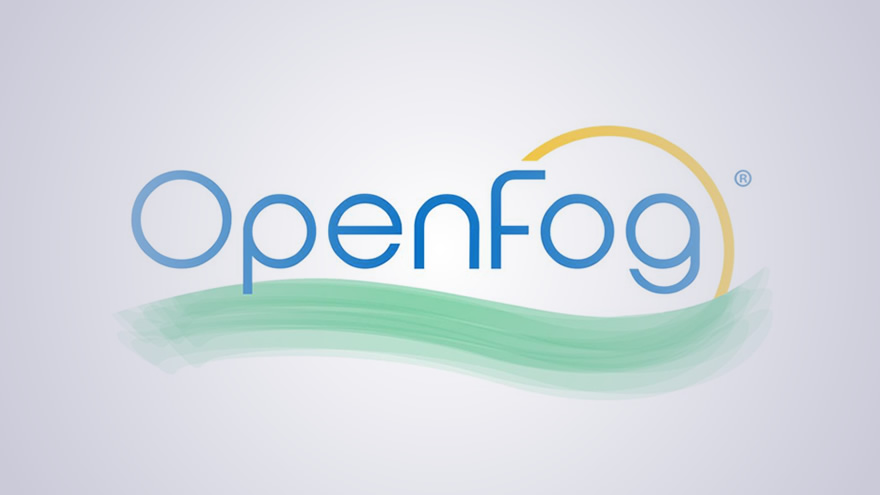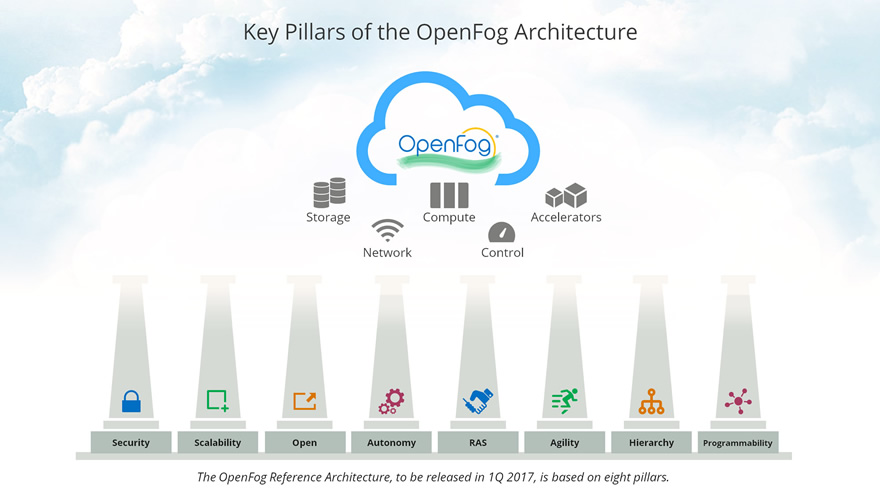
Major resources are being devoted to preparing for this dispersion of computing capabilities. Several terms have been coined to describe the various efforts attacking all, or parts, of the issue, e.g.: “Fog Computing,” “Edge Computing,” “Multi-Access Edge Computing,” “Dispersed Computing,” “CORD,” and more.
We had the opportunity to speak with a pre-eminent expert on the future of the Edge, Dr. Tao Zhang. He is a co-founder and Board Director for the OpenFog Consortium. Zhang has also been Cisco’s Chief Scientist for Smart Connected Vehicles and leader in its internet of things (IoT) strategies. Also participating in the discussion was Lynne Canavan, Executive Director at the OpenFog Consortium.
Fog – And Everything Else – In Perspective
The term “Fog” was originally applied by Cisco to a proprietary product line. Zhang, who joined Cisco in 2012, describes the period in 2014-15 leading up to the OpenFog Consortium idea. He says that he, and others, perceived that there were disparate efforts underway regarding moving computing and networking capability outwards from the cloud to the edge. However, these efforts appeared to be establishing silos, limited in scope, for example, to dealing with mobile edge computing or aspects of industrial edge computing.
They wanted to start an effort that dealt with a broad-based, open architecture. He emphasizes that the scope of their mission is to provide a scheme for moving computing capability along a “continuum” between the cloud and devices. He states, “It may not be the edge; it should be where it makes sense for the customer.”
In the past, “Fog Computing” has been contrasted with “Edge Computing” as two distinct concepts; the difference supposedly being that Fog required moving data from the actual end devices to some type of Fog node or gateway, while Edge involved incorporating the computing capabilities – processing, intelligence, communications – into end devices themselves. The Consortium, however, offers a more flexible view, which allows for positioning capabilities somewhere in the “continuum” and “potentially right up to the IoT sensors and actuators.”

The Commonality – The Data “Deluge”
Zhang discusses how the Consortium members saw that there were common problems that stemmed from the need to address a future in which the world will be drenched in floods of data from dispersed sources. The IoT and connected vehicles alone are enough to drive the point home to most people. These categories raise at least two types of problems.
1. First, they may be transferring data that requires immediate action, where a round trip to the Cloud and back takes too long. For example, “There’s ice on the road at mile marker 22!” By the time that message is sent to the cloud from the first vehicle or a roadside sensor and back to trailing cars under today’s technology, it probably arrives too late to help any vehicle that is between mile 22 to 24.
2. In contrast to urgent information, the second issue is that all of these billions of sensors are dumping data onto networks and into the cloud, a vast amount of which is simply insignificant. It would be desirable to prune or “thin” it out so it doesn’t clog up networks or cloud servers.
These issues have become so apparent, that Zhang points out that virtually all of the major IOT players – he mentions, in addition to Cisco, IBM, HP, Microsoft, Intel, GE and others – have had some sort of initiatives aimed at how to deal with the data floods that will come from the Edge.
The Consortium
The OpenFog Consortium was founded by ARM, Cisco, Dell, Intel, Microsoft and Princeton University in November 2015. The Consortium currently lists 56 members, about 30 of whom are private companies, including giants such as the founders and Asian companies, Hitachi, Fujitsu, Mitsubishi, NEC, ZTE, Foxconn and others, as well as a number of smaller and emerging companies addressing edge products. The other members are educational or other official organizations.
Zhang points out it is apparently the first time that rivals Intel and ARM have joined a common effort together. The carriers, who are not heavily represented, do include AT&T and NTT, and major wireless equipment supplier, ZTE, is a member.
The Consortium states a vision, or purpose of: “Enabling advanced IoT, 5G, AI with Fog Computing.” The term “Fog” which many people may, at first, not relate well to, makes sense when one sees it in terms of the “Cloud.” The Cloud is “compute power, out there somewhere, in vast data centers,” the Fog is bringing the compute capabilities down close to the sources of data.
Recent Progress – Reference Architecture
In February 2017 the Consortium published its OpenFog Reference Architecture. Zhang describes this as “system level architecture that operates across different layers of the protocol stacks, with an emphasis on the software layers.” It is intended to work on all types of hardware.
The document makes clear the vital connection to the Cloud, stating:
“However, all the benefits of cloud should be preserved with these extensions to fog, including containerization, virtualization, orchestration, manageability, and efficiency.”
“Fog does not replace the cloud; it works with cloud to enable the requirements of selected use cases. Certain functions are naturally more advantageous to carry out in fog nodes, while others are better suited to cloud. The traditional backend cloud will continue to remain an important part of computing systems as fog computing emerges.”
Use Cases
The Consortium takes the position that, because of the prior existence of other bodies that are developing approaches to cloud-to-edge computing it will de-emphasize its efforts in the application spaces covered by these groups, and instead focus on serving “vertical markets not addressed by other initiatives.”
It has singled out the following areas of primary interest initially:
- Transportation: Smart Cars and Traffic Control
- Visual Security and Surveillance (example: Airports)
- Smart Cities
- Smart Buildings
Looking ahead, they observe that autonomous cars will generate “multiple terabytes of data every day” from LIDAR, radar, GPS, cameras and other sensors. The cars will also have to communicate with intelligent infrastructure (V2I). These requirements render a cloud-only model unworkable, because of data flows and latency considerations.
Products & Timing
The final goal will be to see products created that can implement Fog Computing environments for the various use cases. Zhang emphasizes the critical role that hardware plays. He states that more and more functionality will be pushed to hardware, especially functions that don’t change frequently.
He outlines the next steps for the Consortium as: getting feedback on their announced architecture; delving deeply into use cases; and getting the Fog nodes defined. They will establish test beds for development of use case solutions and products.
They do not have a precise time schedule at this point. When we asked whether there were any critical technical problems to be solved, he responded, no major roadblocks that they had identified.
He acknowledged that there are challenges. One that is mentioned continually in the area of edge computing generally is Security. Dispersing network elements into multiple unprotected, or lightly protected, environments raises questions. These areas include vehicles, smart grids, residential locales and others.
While it will take some time for the goals of the Consortium to be realized, there already are companies who are offering pre-standardized “Fog” solutions, including some of the smaller vendors who are part of the Consortium. For example, FogHorn, which provides a software platform for industrial and commercial applications, states that it provides “edge intelligence” which is “based on fog computing.” Cisco also offers “Fog Computing solutions,” which include elements such as its IOX API that enable users to “host new or existing applications on fog nodes.”
Consortium – Who’s Missing So Far
The Consortium appears to have attracted a critical mass of participants. However, Zhang points out that they are aware of the need for support from additional groups. For example, while the automotive industry is one of the primary focus for use cases that Fog addresses, there are to date no automotive industry participants.
The response from the carrier industry has also been limited. AT&T’s participation is noteworthy as is ZTE’s from the equipment side.
Furthermore, there is an apparent geographic aspect to the participants and it reflects weakness so far in Europe. While the Consortium has set up teams to lead developments in areas such as China and North America, it doesn’t have enough participation to set up a European team yet.
Zhang reports that they are working quite actively to address all of these areas, and he mentions another category that they are trying to address, which is ISPs, of the Amazon, Alibaba stripe.
Their efforts include what he characterizes as deep discussions with ETSI’s Mobile Edge Computing Group. This is potentially quite significant as France-based ETSI is a recognized European standards organization boasting about 800 members. It has been a leader in promoting Mobile-edge Computing. This was largely focused on providing IT and cloud computing capabilities within the RANs (radio access networks) of wireless carriers. However, recently it changed the name of its effort to Multi-access Edge Computing, apparent recognition of the point that developing edge capabilities just for mobile, could be creating what Zhang refers to as a “silo” of capabilities.
The Consortium is not a standards body. Zhang states that they look forward to standardization of their eventual output by IEEE and other global standards organizations. They have also been in discussions with other government-related bodies such as the NIST (U.S. National Institute of Standards and Technology.)
Our Take
We are absolutely convinced that the movement of computing resources towards the edge will be critical to the future of IoT and many other data-intensive technologies. Fog Computing or any alternative will have to face the issues related to management of a new tier of infrastructure, including not only security and privacy, but access control and other aspects.
Visit their website: www.openfogconsortium.org
